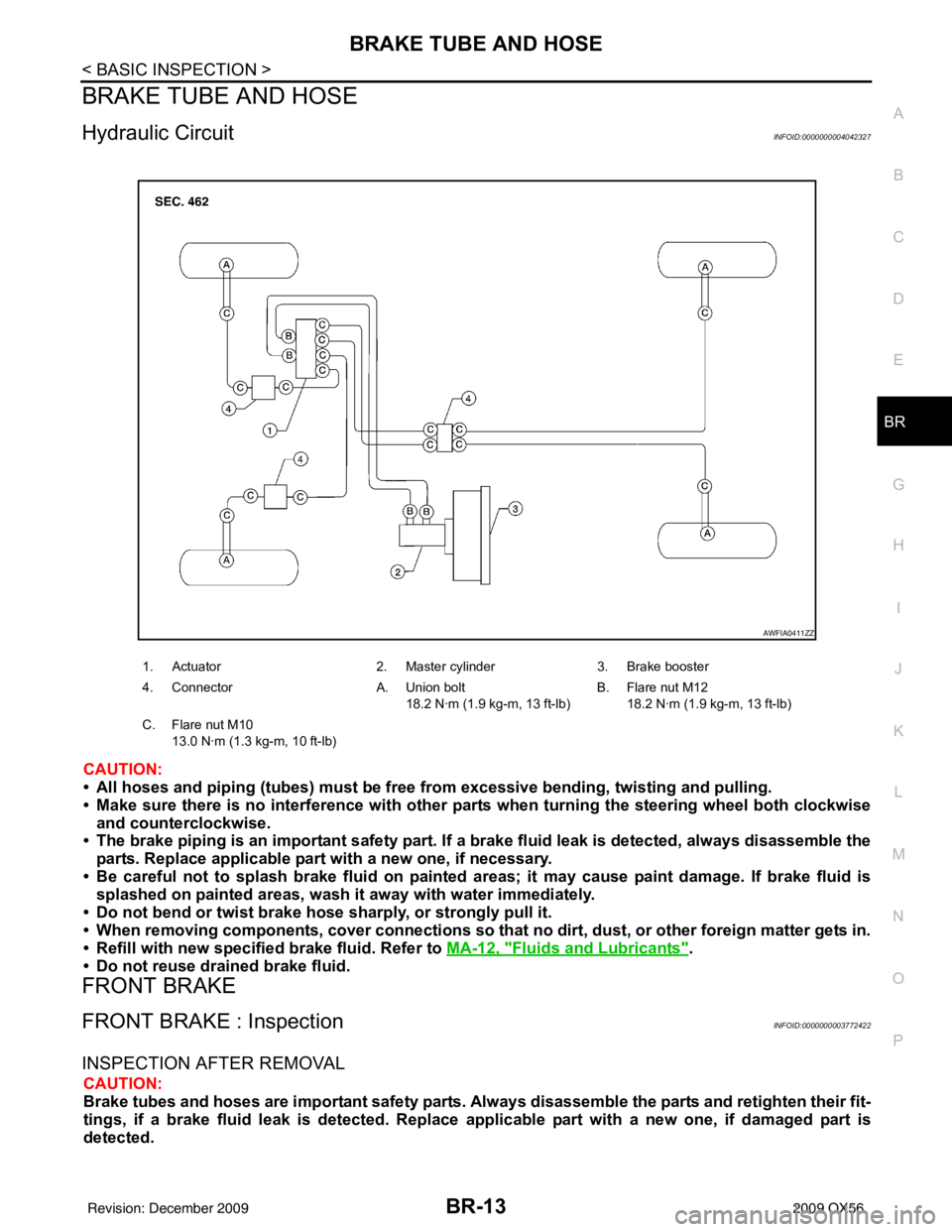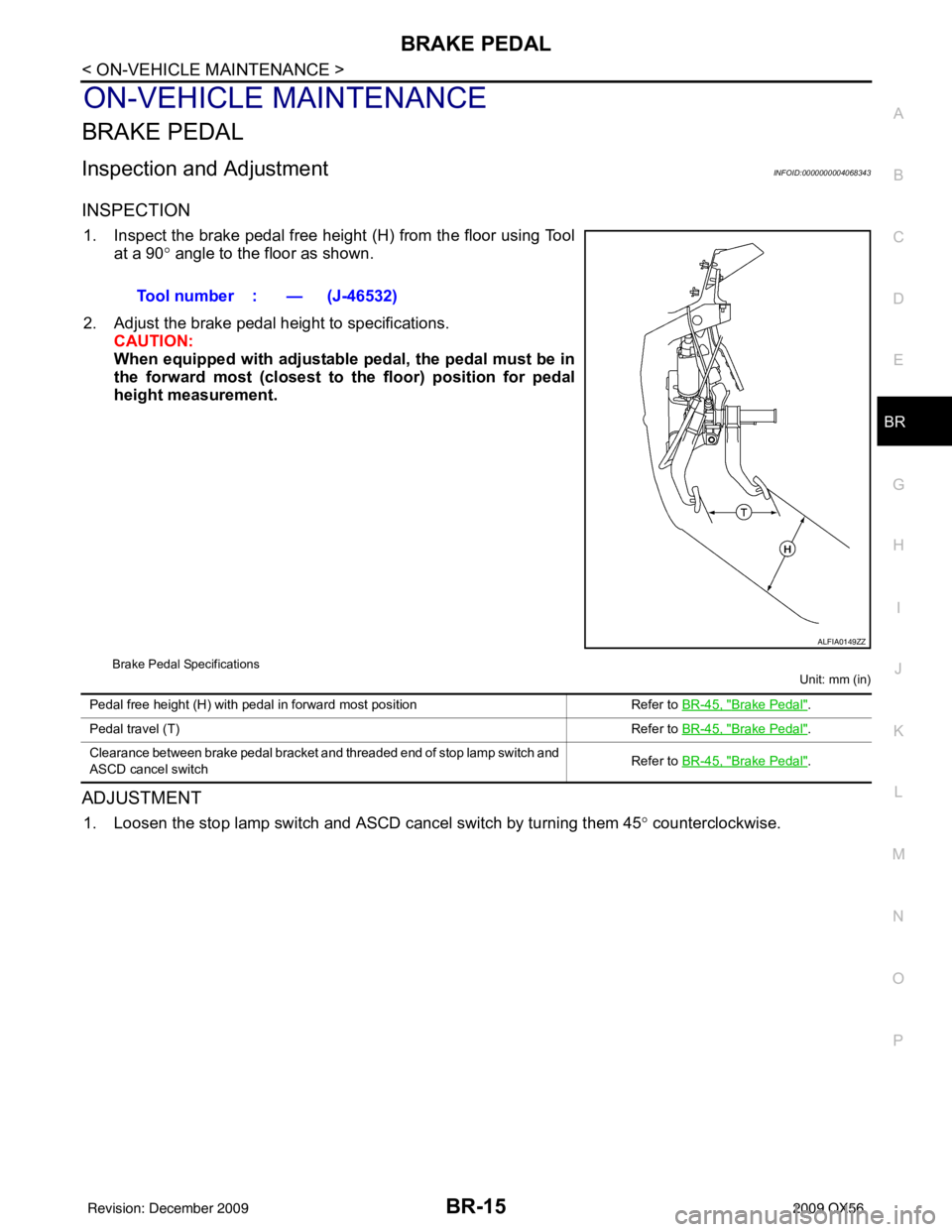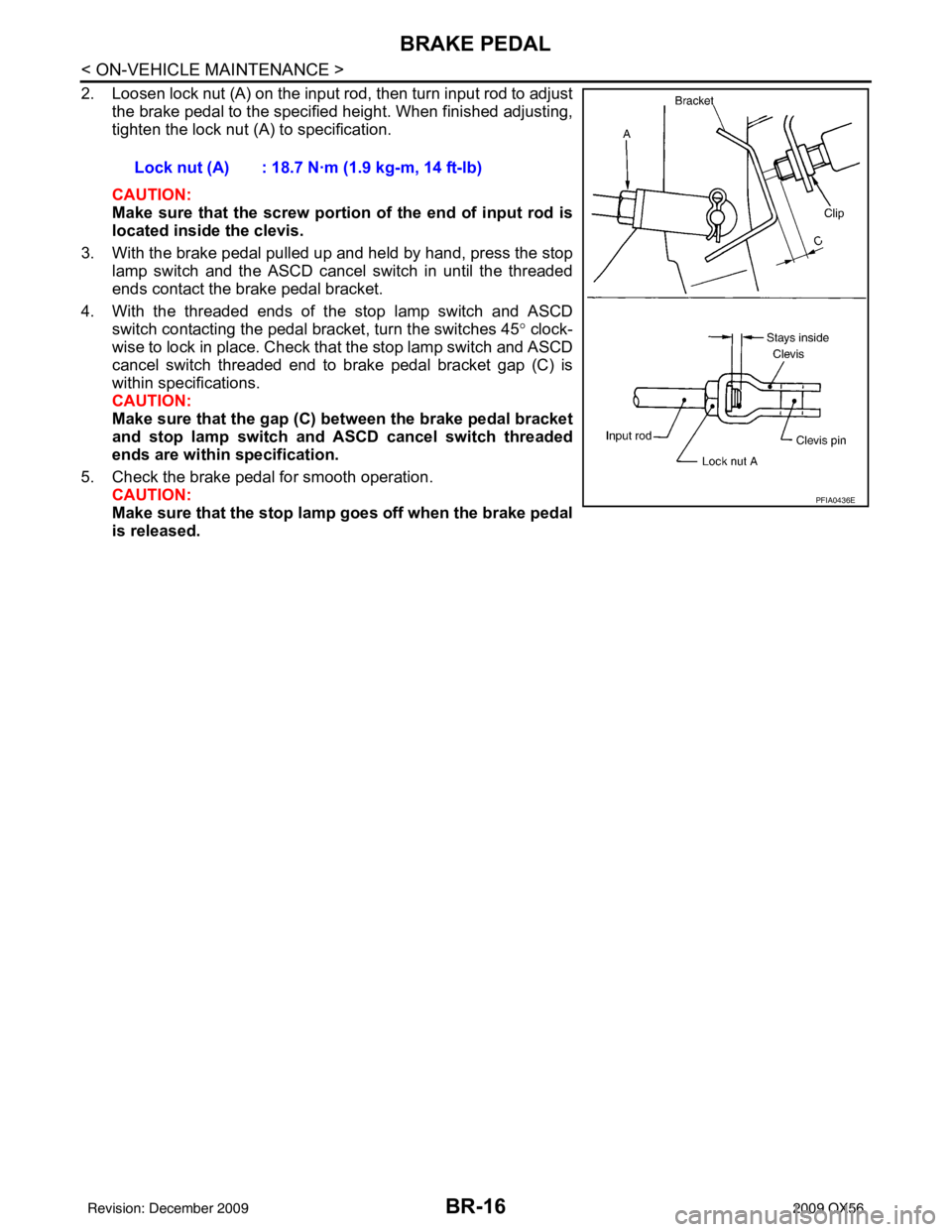INFINITI QX56 2009 Factory Service Manual
Manufacturer: INFINITI, Model Year: 2009, Model line: QX56, Model: INFINITI QX56 2009Pages: 4171, PDF Size: 84.65 MB
Page 441 of 4171

VACUUM LINESBR-11
< BASIC INSPECTION >
C
DE
G H
I
J
K L
M A
B
BR
N
O P
VACUUM LINES
InspectionINFOID:0000000004042328
VISUAL INSPECTION
Check for improper assembly, damage and de terioration. Replace as necessary.
CHECK VALVE INSPECTION
Airtightness Inspection
Use a suitable vacuum pump to check. Connect to brake booster
side of check valve.
Check valve specification : Refer to BR-46, "
Check
Va l v e".
LFIA0217E
Revision: December 20092009 QX56
Page 442 of 4171

BR-12
< BASIC INSPECTION >
BRAKE MASTER CYLINDER
BRAKE MASTER CYLINDER
On Board InspectionINFOID:0000000003772420
LEAK INSPECTION
Check for leaks at master cylinder to brake booster attachment point, reservoir tank, and brake tube connec-
tions.
Revision: December 20092009 QX56
Page 443 of 4171

BRAKE TUBE AND HOSEBR-13
< BASIC INSPECTION >
C
DE
G H
I
J
K L
M A
B
BR
N
O P
BRAKE TUBE AND HOSE
Hydraulic CircuitINFOID:0000000004042327
CAUTION:
• All hoses and piping (tubes) must be fr ee from excessive bending, twisting and pulling.
• Make sure there is no interference with other parts when turning the steering wheel both clockwise
and counterclockwise.
• The brake piping is an important safety part. If a brake fluid leak is detected, always disassemble the
parts. Replace applicable part with a new one, if necessary.
• Be careful not to splash brake fluid on painted areas; it may cause paint damage. If brake fluid is
splashed on painted areas, wash it away with water immediately.
• Do not bend or twist brake hose sharply, or strongly pull it.
• When removing components, cover connections so that no dirt, dust, or other foreign matter gets in.
• Refill with new specified brake fluid. Refer to MA-12, "
Fluids and Lubricants".
• Do not reuse drained brake fluid.
FRONT BRAKE
FRONT BRAKE : InspectionINFOID:0000000003772422
INSPECTION AFTER REMOVAL
CAUTION:
Brake tubes and hoses are important safety parts. Always disassemble the parts and retighten their fit-
tings, if a brake fluid leak is det ected. Replace applicable part with a new one, if damaged part is
detected.
1. Actuator 2. Master cylinder3. Brake booster
4. Connector A. Union bolt
18.2 N·m (1.9 kg-m, 13 ft-lb) B. Flare nut M12
18.2 N·m (1.9 kg-m, 13 ft-lb)
C. Flare nut M10 13.0 N·m (1.3 kg-m, 10 ft-lb)
AWFIA0411ZZ
Revision: December 20092009 QX56
Page 444 of 4171

BR-14
< BASIC INSPECTION >
BRAKE TUBE AND HOSE
1. Check brake lines (tubes and hoses) and connections for fluid leaks, damage, twists, deformation, con-
tacts with other parts, and loose connections. Replace any parts as necessary. Refer to BR-21, "
Removal
and Installation of Front Brake Piping and Brake Hose".
2. While depressing brake pedal under a force of 785 N (80 kg-f, 177 lb-f) with engine running for approxi- mately 5 seconds, check each part for fluid leaks.
REAR BRAKE
REAR BRAKE : InspectionINFOID:0000000003772423
INSPECTION AFTER REMOVAL
CAUTION:
Brake tubes and hoses are important safety parts. Always disassemble the parts and retighten their fit-
tings, if a brake fluid leak is detected. Replace appl icable part with a new one, if damaged part is
detected.
1. Check brake lines (tubes and hoses) and connections fo r fluid leaks, damage, twists, deformation, con-
tacts with other parts, and loose connections. Replace any parts as necessary. Refer to BR-22, "
Removal
and Installation of Rear Brake Piping and Brake Hose".
2. While depressing brake pedal under a force of 785 N (80 kg-f, 177 lb-f) with engine running for approxi- mately 5 seconds, check each part for fluid leaks.
Revision: December 20092009 QX56
Page 445 of 4171

BRAKE PEDALBR-15
< ON-VEHICLE MAINTENANCE >
C
DE
G H
I
J
K L
M A
B
BR
N
O P
ON-VEHICLE MAINTENANCE
BRAKE PEDAL
Inspection and AdjustmentINFOID:0000000004068343
INSPECTION
1. Inspect the brake pedal free height (H) from the floor using Tool at a 90 ° angle to the floor as shown.
2. Adjust the brake pedal height to specifications. CAUTION:
When equipped with adjustable pedal, the pedal must be in
the forward most (closest to th e floor) position for pedal
height measurement.
Brake Pedal Specifications
Unit: mm (in)
ADJUSTMENT
1. Loosen the stop lamp switch and ASCD cancel switch by turning them 45° counterclockwise.
Tool number : — (J-46532)
ALFIA0149ZZ
Pedal free height (H) with pedal in forward most position
Refer to BR-45, "Brake Pedal".
Pedal travel (T) Refer to BR-45, "
Brake Pedal".
Clearance between brake pedal bracket and threaded end of stop lamp switch and
ASCD cancel switch Refer to
BR-45, "
Brake Pedal".
Revision: December 20092009 QX56
Page 446 of 4171

BR-16
< ON-VEHICLE MAINTENANCE >
BRAKE PEDAL
2. Loosen lock nut (A) on the input rod, then turn input rod to adjustthe brake pedal to the specified height. When finished adjusting,
tighten the lock nut (A) to specification.
CAUTION:
Make sure that the screw portion of the end of input rod is
located inside the clevis.
3. With the brake pedal pulled up and held by hand, press the stop lamp switch and the ASCD cancel switch in until the threaded
ends contact the brake pedal bracket.
4. With the threaded ends of the stop lamp switch and ASCD switch contacting the pedal bracket, turn the switches 45 ° clock-
wise to lock in place. Check that the stop lamp switch and ASCD
cancel switch threaded end to brake pedal bracket gap (C) is
within specifications.
CAUTION:
Make sure that the gap (C) between the brake pedal bracket
and stop lamp switch and ASCD cancel switch threaded
ends are within specification.
5. Check the brake pedal for smooth operation. CAUTION:
Make sure that the stop lamp goes off when the brake pedal
is released.Lock nut (A) : 18.7 N·m (1.9 kg-m, 14 ft-lb)
PFIA0436E
Revision: December 20092009 QX56
Page 447 of 4171

BRAKE FLUIDBR-17
< ON-VEHICLE MAINTENANCE >
C
DE
G H
I
J
K L
M A
B
BR
N
O P
BRAKE FLUID
On Board InspectionINFOID:0000000003772425
LEVEL CHECK
• Make sure the fluid level in reservoir tank is between MAX and MIN lines as shown.
• Visually check around reservoir tank for fluid leaks.
• If fluid level is excessively low, check brake system for leaks.
• If brake warning lamp remains illuminated after parking brake pedal is released, check brake system for fluid leaks.
Drain and RefillINFOID:0000000003772426
CAUTION:
• Refill with new brake fluid. Refer to MA-12, "
Fluids and Lubricants".
• Do not reuse drained brake fluid.
• Do not let brake fluid splash on the painted surfaces of the body. This might damage the paint, so if
splashing it, immediately wipe off the area and wash away with water.
• Before servicing, disconnect ABS actuator and electri c unit (control unit) connector or battery nega-
tive terminal.
1. Connect a vinyl tube to each bleed valve.
2. Depress brake pedal, loosen each bleed valve, and gradually remove brake fluid.
3. Make sure there is no foreign material in reservoir tank, and refill with new brake fluid.
4. Rest foot on brake pedal. Loosen bleed valve. Slowly depress pedal until it stops. Tighten bleed valve. Release brake pedal.
Repeat this process a few times, then pause to add new brake
fluid to master cylinder. Continue until new brake fluid flows out
of the bleed valve.
Bleed the air out of the brake hydraulic system. Refer to BR-17,
"Bleeding Brake System".
Bleeding Brake SystemINFOID:0000000003772427
CAUTION:
While bleeding, pay attention to master cylinder fluid level.
1. Turn ignition switch OFF and disconnect ABS actuator and electric unit (control unit) connector or battery
negative terminal.
2. Connect a vinyl tube to the rear right bleed valve.
LFIA0225E
SBR419C
SBR995
Revision: December 20092009 QX56
Page 448 of 4171

BR-18
< ON-VEHICLE MAINTENANCE >
BRAKE FLUID
3. Fully depress brake pedal 4 to 5 times.
4. With brake pedal depressed, loosen bleed valve to let the air out, and then tighten it immediately.
5. Repeat steps 3 and 4 until no more air comes out.
6. Tighten bleed valve to the specified torque. Refer to BR-31, "
Exploded View of Brake Caliper" (front disc
brake), BR-35, "
Exploded View of Brake Caliper" (rear disc brake).
7. Repeat steps 2 through 6 at each wheel, with master cylinder reservoir tank filled at least half way, bleed- ing air in order from the front left, rear left, and front right bleed valves.
Revision: December 20092009 QX56
Page 449 of 4171

BRAKE PEDALBR-19
< ON-VEHICLE REPAIR >
C
DE
G H
I
J
K L
M A
B
BR
N
O P
ON-VEHICLE REPAIR
BRAKE PEDAL
Removal and InstallationINFOID:0000000004042331
REMOVAL
CAUTION:
• Before removal and installation, the accelerator and brake pedals must be in the forward most posi-
tion (closest to the floor). This is to align th e base position of the accelerator and brake pedals.
• Do not disassemble the brake pedal adjusting mechanism.
• Avoid damage from dropping the brake pedal assembly during handling.
• Keep the brake pedal assembly away from water.
1. Remove the lower instrument panel LH. Refer to IP-17, "
Removal and Installation".
2. Remove the stop lamp switch and ASCD cancel switch from the pedal assembly.
1. Brake pedal assembly 2. Snap pin3. Clip
4. Stop lamp switch 5. Pedal pad6. Clevis pin
7. ASCD cancel switch
WFIA0232E
Revision: December 20092009 QX56
Page 450 of 4171

BR-20
< ON-VEHICLE REPAIR >
BRAKE PEDAL
3. Disconnect the adjustable brake pedal cable from the adjustablepedal electric motor.
• Unlock (1) then pull (2) the adjustable brake pedal cable to dis-connect it from the adjustable pedal electric motor as shown.
4. Remove snap pin and clevis pin from the clevis of brake booster.
5. Remove brake pedal assembly nuts and remove the brake pedal assembly. • Temporarily install the brake pedal assembly nuts by hand to support the brake booster.
WARNING:
Do not bend the brake tubing.
CAUTION:
• Before removal and installation, the accelerator and brake pedals must be in the forward mostposition (closest to the floor). This is to align the base position of the accelerator and brake ped-
als.
• Do not disassemble the brake pedal adjusting mechanism.
• Avoid damage from dropping th e brake pedal assembly during handling.
• Keep the brake pedal assembly away from water.
INSPECTION AFTER REMOVAL
Check the brake pedal assembly for the following items:
• Crack or deformation of clevis pin stopper
• Clevis pin deformation
• Crack of any welded portion of the brake pedal assembly
• Brake pedal bend or deformation
INSTALLATION
Installation is in the reverse order of removal.
• Check the brake pedal for smooth operation. Ther e should be no binding or sticking when applying or
releasing the brake pedal.
• Check the brake pedal adjustable feature for smooth operation. There should be no binding or sticking when adjusting the brake pedal forward or backward.
• After installing the brake pedal assembly, be sure to adjust it. Refer to BR-15, "
Inspection and Adjustment".
LBIA0374E
SBR997
Revision: December 20092009 QX56